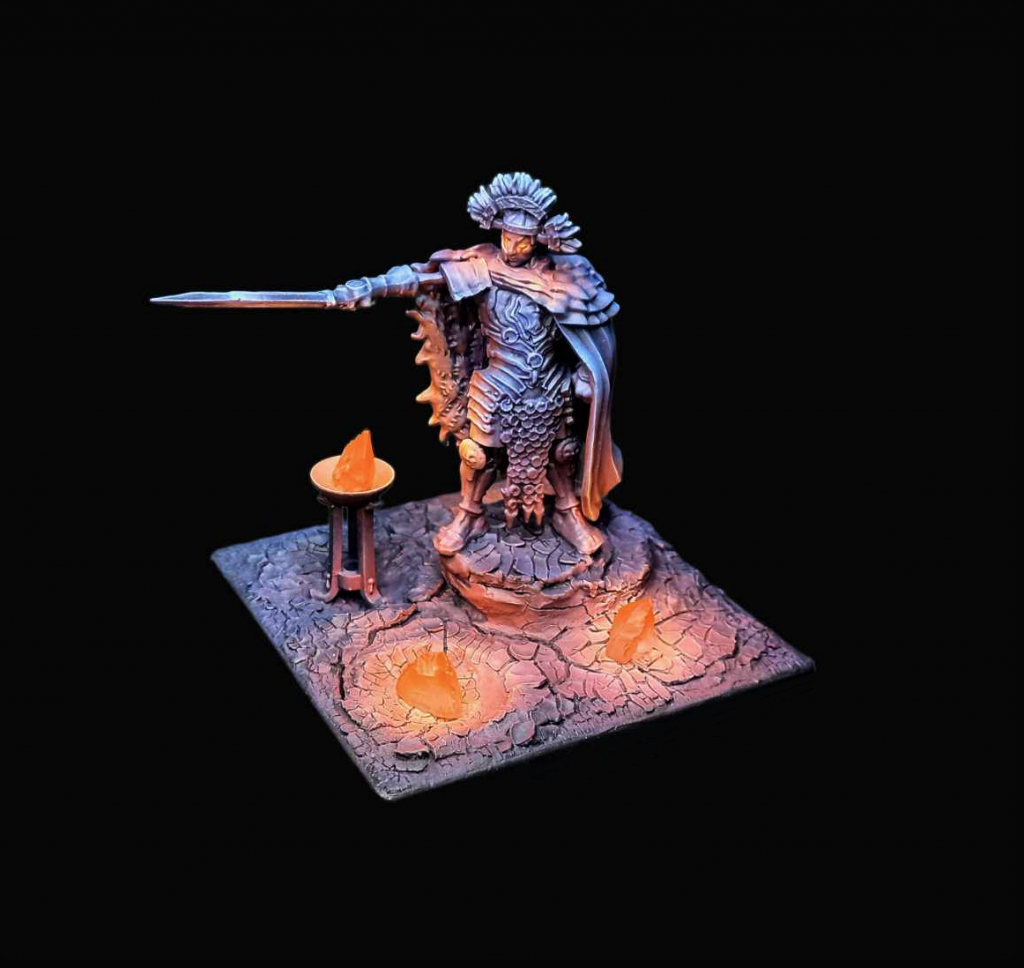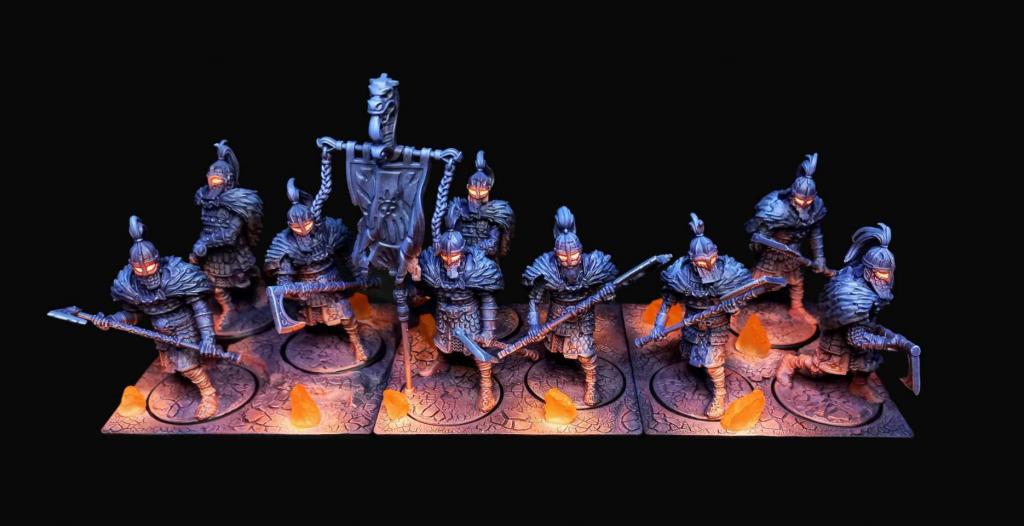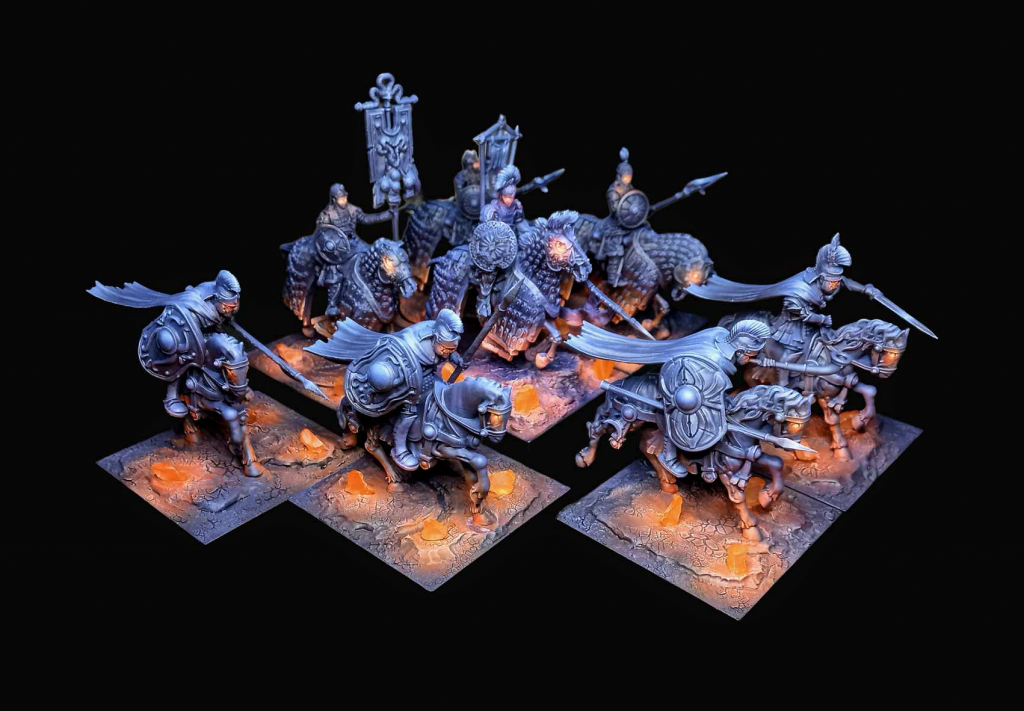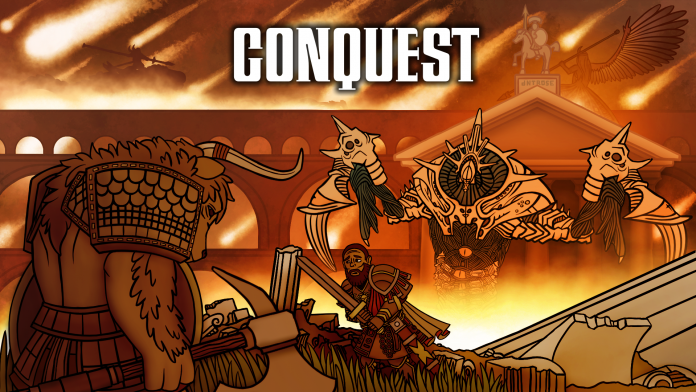“When the last defenders of Aepernia fell to the tide of living death that engulfed the south, the foe they left to the reinforcing forces of Acheron were scattered and brittle. Even the notoriously taciturn god of Acheron is known to have said: They did not fight like heroes. The heroes fought like them.” – The Last Stand of Aepernia
If you’re new to Conquest, sooner or later you’ll have your first experience fighting the Old Dominion. You’ll have played games against other factions, gotten a basic idea for how the rhythm of the game works, how much force to apply to score a kill – and then you fight these undead romans and it’s an absolute cluster. They don’t take resolve checks, they won’t die – or if they do die, their whole army gets stronger? How do you beat them?
Worry not – this article is for you. In it, we’ll cover who the Old Dominion are, why fighting them is different and especially challenging for new players, and provide a mix of mechanical and tactical suggestions for engaging them effectively

Who are the Old Dominion?
If you’re looking for an in-depth breakdown of the units and abilities of the Old Dominion, you can find our Faction Focus here. The Faction Focus isn’t required reading for this article, but it’s where to start if you want to understand the units you’re facing.

Why is fighting the Old Dominion different?
The Old Dominion have two major things that set them apart from other factions in the game, thanks to their Animate Vessel and Dark Power rules. Being Animate Vessels means most of their regiments have no resolve statistic, giving them a baseline level of resilience against most attacks that is at least a little higher than most other factions have access to. Dark Power means that when they do die, they contribute to a power pool that strengthens the rest of the army, which rubber-bands Old Dominion back into the game and ensures they stay relatively strong even (or especially) into the late game.
This affects the new player experience against them in a couple of ways. The first is just that they’re often a lot tougher than you’d expect. As you learn how to play Conquest, you develop some intuition for how much force it takes to engage a given target, but it’s not immediately clear to a new player how much of a damage multiplier a low to moderate resolve stat is. To illustrate this, let’s compare two superficially similar units – Praetorian Guard and Dweghom warriors. Both have 5 wounds, Defence 2 and a Shield, but the Warriors have Resolve 2 and Praetorians are Animate Vessels. This means Warriors take a whopping 66% more damage than Praetorians do against most attacks, since every three wounds the warriors take will generally produce two more wounds from failed resolve checks.
While an experienced player will have played enough games to understand that these two on-paper similar units vary wildly in terms of how much force you need to apply to break them, a new player is much more likely to make bad decisions by relying on their existing mental model for how easy it is to kill what looks like a generic mainstay melee infantry unit, which just doesn’t apply against Old Dominion and leads to mistakes and a feeling of unexpected resilience from Old Dominion units (even relatively fragile ones).
The second big impact comes from how Dark Power works. Old Dominion start the game without easy access to a lot of their abilities but scale up as they accumulate Dark Power. This means that they begin the game much weaker than their opposition but end the game potentially stronger. A new player isn’t likely to notice just how weak the Old Dominion can be early game, and therefore fail to capitalise on it, leading to a situation where they get completely steamrolled as the Dominion troops come fully online later in the game.
The good news is that both these are things that you as an opponent can learn how to manage and even exploit. This might surprise you if you’re coming off the back of your first game against the undead, but Old Dominion are often reckoned to be a middle-of-the-road faction at best in high level competition, and for the rest of the article we’ll break down the tools and tactics you can use to exploit these weaknesses and accomplish similar victories against them. We’ll split these into two categories – mechanical and strategic.

Mechanical weaknesses of the Old Dominion
For the purposes of this article, a mechanical strength or weaknesses is something directly arising from the attributes and rules of a faction or unit, and which you can engage with using a similarly mechanical counter (by changing what units you take in an army, and how you match them up against the enemy). For example, we’ve discussed above how the Old Dominion have a strong mechanical strength by having no resolve attribute, which can significantly increase their durability relative to an equivalent unit with an average resolve attribute.
The first and most significant mechanical weaknesses of the Old Dominion, therefore, is damage from sources that don’t cause resolve checks. The most common of these, and one available to all factions, is ranged attacks. Ranged attacks are generally quite powerful in Conquest, but balanced by the fact that their damage doesn’t cause resolve checks. If you want to adjust your lists to better counter Old Dominion, having a heavier focus on ranged attacks can pay big dividends, as these attacks will be extremely efficient against the Dominion (who have only a very small number of tools that can specifically counter ranged units).
Other examples of sources of damage that don’t cause resolve checks are aura of death (available to multiple factions including Old Dominion itself if any Dominion players are reading this thinking about the mirror match) and decay (admittedly extremely rare as an offensive ability, limited to just Nords at time of writing).
The second notable mechanical weaknesses of the Old Dominion is bringing your own high resolve. Animate Vessels can’t perform the Inspire action (although they can become inspired in other ways, like charging), which limits the damage output of Old Dominion in protracted engagements. Old Dominion regiments make up for this in part by having near-universal access to the Terrifying (1) rule, but any regiment that can prevent the terror from overtaking them is likely to last a lot longer against Old Dominion than the Dominion player would like. You can accomplish this by engaging with units with high resolve stats, the Fearless or Indomitable rules, or even by just having a large enough unit that your bonus to resolve from unit size cancels out the Old Dominion’s terror.

Strategic weaknesses of the Old Dominion
In contrast to a mechanical weakness, a strategic weakness is one that isn’t tied to a specific attribute or rule on a unit, but instead manifests in how a faction plays at large, how they try to win game, and how manoeuvre and direction of force can be leveraged by and against them. It’s rare in Conquest for an entire faction to have notable strategic weaknesses (as most factions enjoy a wide variety of possible army builds), but Old Dominion are a notable and important exception.
As we noted above, Old Dominion are a faction that accumulates strength over the game, including getting stronger as their regiments suffer casualties and die. This means that Old Dominion will almost always end the game in a position of strength, usually peaking around turn six or seven depending on their list construction, establishing an attrition advantage in these later turns that can either turn the game around or end it decisively if they were already ahead.
However, the price the Old Dominion pays for this is being the weakest army in the early game. Nothing the Old Dominion have access to at time of writing is playing at full efficiency early, which limits their ability to project threat, control space, secure scenario points, and trade efficiently in the early game. This weakness is exacerbated by a general reliance on heavy units and lack of significant access to high power light regiments or any high mobility regiments. Kheres, for example, are a very good light unit, but they’re very good because they get stronger as the game progresses, not because they start the game strong.
Recognising and exploiting this rhythm of play against the Old Dominion – where you are stronger than them early, and weaker than them late – is the main strategic and tactical path to victory against them, regardless of the army you’re playing. You need to use the early game to secure and control scenario zones, prune back and zone out the more threatening or high priority Old Dominion elements, and then set up holding positions and plan for a general fighting withdrawal through the late game.
(To note, it’s absolutely possible for the Old Dominion to be met head-on and even tabled by a sufficiently good, lucky or well-equipped opponent, but for the purposes of this article we’re proposing a general strategy that doesn’t require being luckier or better than your opponent.)
Some of these concepts are a little complicated, so let’s break down what you should be looking to accomplish during the early, middle and late game.
Early game – secure and control
For at least the first third of the game, most armies will have a greater presence and mechanical strength on the table than their Old Dominion opponents. Even if the Old Dominion player has invested heavily in light and medium troops, these troops aren’t fully online in the absence of Dark Power.
These first three to four turns should be used decisively. You should focus on two things: securing position, in particular seizing scenario zones and getting units in position to zone the Old Dominion back toward their own deployment line, and eliminating enemy units that can interfere with your future plans. Take whatever picks you can, but focus on eliminating or pinning down enemy elements that can interfere with your own troops’ ability to move and hold, or which might sneak around you and secure an objective zone to keep the Old Dominion in the scoring game.
If you can, also use this time to go after enemy pieces that will scale efficiently in the late game or help your opponent accelerate their Dark Power generation, like Kheres, Archimandrites and Heirodeacons, but only if your opponent over-extends them.
Mid-game – building firebreaks
By the mid-game, usually starting in round 4 or so, the Old Dominion will begin to come online. Not only will their Memories of Old start to unlock, but their fearsome heavy regiments will begin to arrive in force. If your army can fight these regiments pound for pound, go ahead and engage conventionally – you’re matching strength with strength and have a window here to engage decisively. However, there’s a good chance that this is the part of the game where the Old Dominion late-game strength starts to emerge, and fights become harder and harder to win. This is where we want to move from eliminating the enemy to containing them.
This phase of the game relies on the fact that the Old Dominion, generally, aren’t mobile. Some Old Dominion armies will buck this trend, but their march values are usually low and they’ll only have a few units that might be able to decisively engage your screening elements or get around your lines. There’s a reason these are the units we focused on eliminating during the early game!
During the mid-game, the key is to set lines of engagement beyond the scenario zone, so even if the Old Dominion heavy elements begin to engage your main scoring regiments, they can’t do so and contest or score the scenario. Ideally, this is time to start expending your cheaper lighter elements, using them to tie up and delay the most dangerous Old Dominion regiments so they can’t translate that power into meaningful kills and scenario points. Use cheap blocking regiments to deny the enemy access to scenario zones, and if your opponent’s formation has layered melee regiments (for example, Legionnaires in front and a heavy melee unit behind) consider engaging the weaker enemy screening regiments but not attacking them – an engaged enemy regiment is often the hardest blocking regiment for your opponent to get around.
This is the part of the game where your casualties will start to mount, but that’s ok. Scenario points are your focus.
Late-game – the fighting withdrawal
By the late-game, from rounds 6 or 7 and onwards, the Old Dominion force will have sustained casualties, generated a lot of Dark Power, and have all their heavy regiments present. They’ll be fully online and leveraging that power to devastating effect.
Your focus in this part of the game is on preventing the Old Dominion player from recovering from the scenario deficit you put them in during the early- and mid-game. If you’ve out-played your opponent you may have been able to secure a decisive attritional lead and can coast to victory, but more likely you’ll now be suffering heavy casualties and forced to make hard decisions about where to allocate your remaining force. In this case, make your decisions based on what will score you points or deny the enemy points. Waste your opponent’s time, draw them away, isolate and eliminate smaller scoring regiments like legionnaires, or try to skirt their lines to secure or contest valuable rear objectives. Anything that keeps the scoring gap as wide as possible is useful here.
Just like in the mid-game, and in Conquest generally, casualties are ok during this stage of the game. You don’t need troops alive to win the scenario. Getting tabled is not a loss condition – all that matters is that at the end of round ten, you have more scenario points than your opponent.

Adapting your tactics for different Old Dominion lists
Although the principles contained in this article are generally agnostic of both your list and the opposing Old Dominion list, it’s worth considering the list archetypes you’re most likely to encounter and the specific challenges they pose. We’ll break this down by warlord, but as a reminder, you can find a full breakdown of the entire Old Dominion faction in our faction focus.
Fallen Divinity
If any list exemplifies the weak early, strong late nature of the Old Dominion, it’s a Fallen Divinity list. In addition to the walking god herself, expect to see the rest of her list comprised mostly of powerful self-sufficient heavies and units expected to die to fuel her apotheosis.
The tactics in this article will all work well against a Divinity, and without dark power going into the normal pool, you may even find you can gain an attrition lead against the Divinity’s army. The major tactical question you need to answer during the game is whether to try to engage the Divinity herself. This can be very worthwhile, but if you decide to pull the trigger, you need to commit. She can heal a lot over the game as she powers up and becomes very close to invulnerable when she reaches Tier 3, which will effectively waste any chip damage you do to her unless you kill her dead.
If you don’t have the tools to properly take her down decisively, or your opponent is being conservative enough with her to make an assassination attempt impractical, it can be much better to just zone her out and focus on scoring scenario and eliminating her scoring units. Even at T3, she can only be in one place at a time.
Archimandrite
The presence of an Archimandrite adds healing to the Old Dominion, which can further augment their late-game resilience, but the Archimandrite otherwise requires no special tactics to overcome. More important is to keep an eye on his warband, with special attention paid to units of Kheres. These spell-slinging ghosts start out weak but end the game very dangerous as their spellcasting powers up, and if you can eliminate them early it will pay big dividends.
Mechanically, an Archimandrite and their Kheres merit including interference in your list if you can, in order to blunt their spellcasting power. Having access to interference is general good practice, and a single well-placed spellcaster or artefact like the Sacred Censer can really help blunt the output of Old Dominion spellcasting.
Strategos
The Strategos brings powerful Kataphraktoi shock cavalry, which you can respond to with normal anti-cavalry tactics by denying them the charge. Watch out for the Hetarios officer, though, which grants the regiment Overrun. Against Hetarios Kataphrakts, any blocking regiments you use need to either get the march-charge into melee, or be positioned so that Overrunning doesn’t let the Kataphrakts immediately charge into a new regiment. March-charging into them is best, though, and is guaranteed to take the wind out of Kataphraktoi sails.
You also need to keep the Strategos supremacy in mind. This grants an early game surge of strength, and a turn of free reforms to the Old Dominion army. This adds an element of mobility that can both allow for rapid reposition and significantly extend charge threat ranges (by reforming to angle the regiment so the corner is much closer to the charge target, making it easier to pass the charge roll). When playing against the Strategos, keep this gap-closing tool in mind and watch out for sneaky long-range charges into zones that you thought were safe.
Xiliarch
The most martially focused warlord, a Xiliarch list is guaranteed to be built around his large personal warband, which he force-multiplies with own combat prowess and very powerful once-per-game supremacy, which gives his entire warband a free additional clash action.
Against the Xiliarch, at all costs avoid lining up at normal distances for a standard march-clash engagement (not that this is a great idea against the Dominion anyway), because if even one unit of Varangian guard pulls off a Charge + Clash + Clash against something important, you’ll be washed away in a tide of blood.
Instead, pressure the Xiliarch player into using the supremacy early for March + Charge + Clashes, which is still a powerful threat extension tool but one you’re far more likely to be able to recover from. You may even be able to stage some withdrawals on the Xiliarch supremacy turn – if your opponent has models set up for that March + Charge + Clash and you activate key regiments before they do, you might be able to March + March some of your own key units backwards. If you’ve gained enough ground early to make this kind of withdrawal feasible, you can essentially fizzle the Xiliarch supremacy. Alternatively, using expendable blocking regiments can delay the Xiliarch supremacy turn, as they won’t want to waste such a powerful once-per-game effect to kill units of militia or force-grown drones.
As always if you want to get 10% off and support Goonhammer you can make your Conquest purchase by clicking here for US/Canada or here for EU/rest of world. You’ll also need to enter code “goonhammer” at checkout.
Have any questions or feedback? Drop us a note in the comments below or email us at contact@goonhammer.com.


